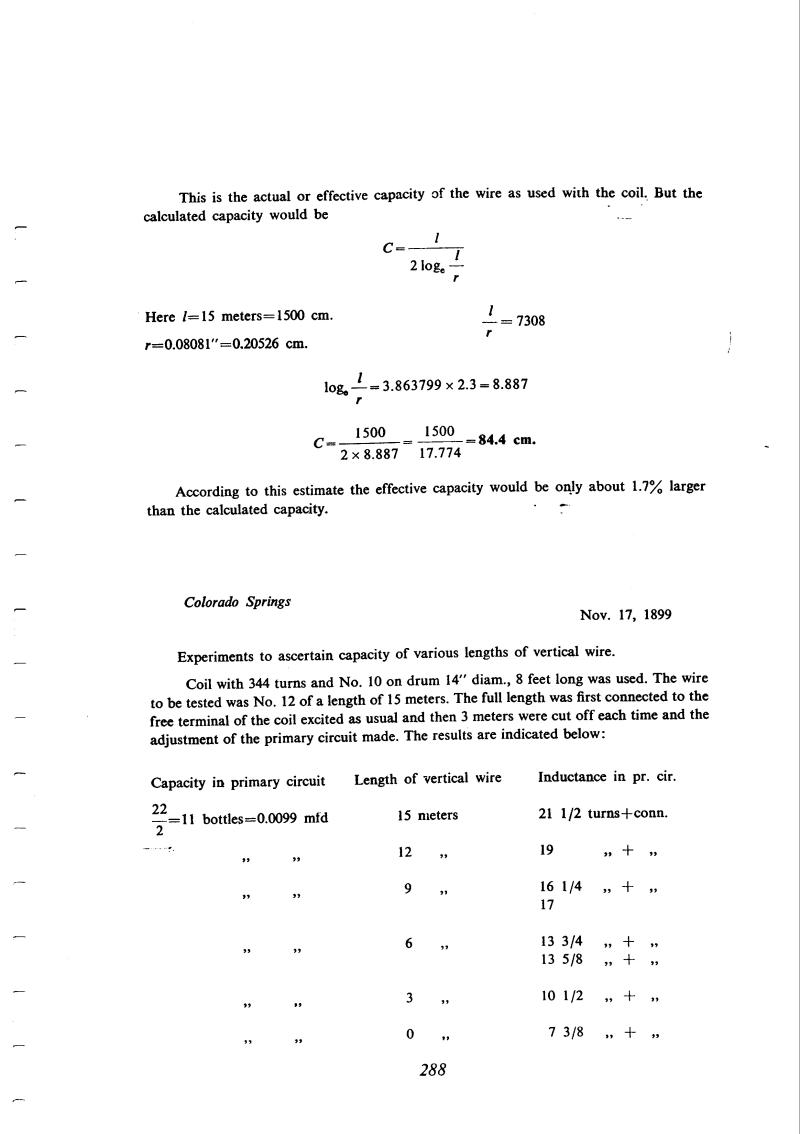
Nikola Tesla Books
This is the actual or effective capacity of the wire as used with the coil. But the calculated capacity would be
C = $! {l \over {2 \log_{e} {l \over r}}} $!
| Here l = 15 meters = 1500 cm. r = 0.08081" = 0.20526 cm. |
$! {l \over r} $! = 7308 |
loge$! {1 \over r} $! = 3.863799 x 2.3 = 8.887
C = $! {1500 \over {2 \times 8.887}} $! = $! {1500 \over 17.774} $! = 84.4 cm.
According to this estimate the effective capacity would be only about 1.7% larger than the calculated capacity.
Colorado Springs
Nov. 17, 1899
Experiments to ascertain capacity of various lengths of vertical wire.
Coil with 344 turns and No. 10 on drum 14" diam., 8 feet long was used. The wire to be tested was No. 12 of a length of 15 meters. The full length was first connected to the free terminal of the coil excited as usual and then 3 meters were cut off each time and the adjustment of the primary circuit made. The results are indicated below:
| Capacity in primary circuit | Length of vertical wire | Inductance in pr. cir. |
|---|---|---|
| $! {22 \over 2} $! = 11 bottles = 0.0099 mfd | 15 meters | 21 1/2 turns + conn. |
| " " | 12 " | 19 " + " |
| " " | 9 " | 16 1/4 " + " |
| 17 | ||
| " " | 6 " | 13 3/4 " + " |
| 13 5/8 " + " | ||
| " " | 3 " | 10 1/2 " + " |
| " " | 0 " | 7 3/8 " + " |
288
November 16-20
Capacity measurements made during the period 16 - 22 November agree on the whole with those made earlier. Tesla does not explain why he repeated similar measurements, e.g. those of November 16th and 18th when he determined the distributed capacity of the supplementary coil and the vertical wire. Nor does he explain why he repeated the measurements of the change of capacity of the sphere with elevation (see November 18th and 20th). He may only have wanted to confirm the earlier results.
On November 17th and 19th he measured the capacity of a vertical wire of various lengths and gauges. From his comments on November 17th it may be seen that at greater lengths he expected some inductive effect. A check of the wavelength, however, reveals that all Teslaâs antennas were short in comparison (h/λ of the order of 0.01), so that divergence between the theoretical and measured values cannot be ascribed to an inductive effect.
November 16-20
He makes a new auxiliary coil on a core 35.5 cm in diameter and 244 cm in length with 344 turns of wire 2.6 mm in diameter. With this coil, as per already described method, he measures the capacitance of a vertical wire of various lengths, the useful sphere capacitance at various elevations above the ground, the capacitance of metal cylinders of various lengths and compares the capacitance of a horizontal and vertical wire of the same length. The results he obtains within the period Nov. 16 to 22, mainly correspond with those prior to Nov. 15. Tesla does not explain why he repeats similar measurements, as e.g., those on Nov. 16 and 18, when he determines the self capacitance of the auxiliary coil as well as the vertical wire.
Also he does not talk about the reason why he repeats the measurements of the sphere capacitance changes with elevation changes {please see Nov. 18 and 20). It is possible that he did this in order to check results.
The change cf the capacitance of a vertical conductor of various lengths and diameters he measured on Nov. 17 and 19. From the comments of Nov. 17 it could be seen that Tesla expected that at longer conductor length the inductive effect would be distinct. The check of wavelength, however, indicated that all Tesla's aerials are short in relation to wavelength (h/λ is in the order of 0.01) and therefore the mismatch of the theoretical results with the measurement results could not be explained due to an inductive effect.

